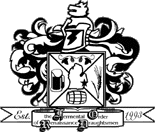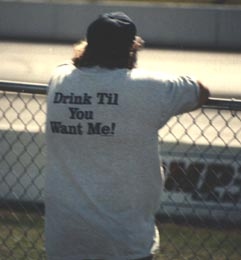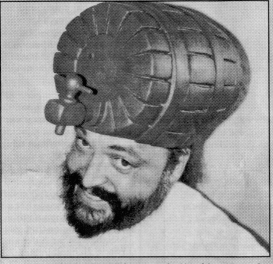 |
 |
 |
 |
 |
 |
| October 2000 | Fermental Order of Renaissance Draughtsmen | Vol. 8 No. 10 |
The next meeting will be held back at Sisko's in Taylor on Tuesday, October 24. Sisko's is located on Monroe (between Telegraph and Southfield), just south of Vanborn. Their address is 5855 Monroe and their phone number is 313-278-5340. Sisko's also has a website at http://www.siskos.com/. The competition for this October is stout. As usual, the thirsty hard-core who want dinner will start arriving around 5PM, people will drift in for an hour or so, and we will start our meeting around 6PM.
Thought I would give everyone a heads up on my status. The first phase of my cancer treatments went extremely well. The original source tumor is no longer visible and the swollen lymph node has reduced almost to normal size. The doctors tell me that this type of response is the indicator of a full cure. I the gods are smiling on me, I want to thank all of you for your thoughts and prayers which I am sure are helping. The current phase of my treatment is the roughest. I am receiving 3 more doses of Chemo along with daily (m-f) radiation. The radiation is the hard part, I have the equivalent of a serious sun burn on the inside of my throat. It makes swallowing extremely pain full. To combat the pain I have prescriptions for 2 types of morphine and the legal prescription extract of marijuana. I have yet to see how well it will hold me over, the pain is supposed to keep getting worse until the end of treatment on November 10. For now it is tolerable and I am continuing my work duties. Once this phase is complete I will get two more doses of another chemo drug in January and February, then go on a monitoring protocol. (if you don't like preaching, turn your filter on now) If you didn't know, the cancer I got is basically a smokers cancer. Based on what I'm going through, I can unequivocally say that just the chance of being afflicted with this illness is not worth any enjoyment anyone gets from any kind of smoking..... (end of preaching) Any way, thanks to everyone who is keeping the club going in my absence, the first round at the next meeting I get to (which may well be March next year), is on me....
The winners from August's Lawnmower Beer Competition are:
| Lawnmower Beer | ||
| Place | Name | Style |
| 1 | Kim and Bob Barret | Honey Ale |
| 2 | Tony Tantillo | Cherry Wheat |
| 3 | Tony Tantillo | Wheat |
September's Octoberfest and Vienna, Best of Fest competition gave the following results.
| Octoberfest | |||
| Place | Name | Style | Points |
| 1 | Jim Rice | Octoberfest | 36 |
| 2 | Mike Arend | Octoberfest | 35 |
This October's competition will be stout, BJCP categories 12C & 16A-D .
12C. Russian Imperial Stout
Aroma: Fruity esters, reminiscent of dark fruit, merged with intense roastiness and maltiness. Hop aroma is usually also present.
Appearance: Very dark reddish-black color; opaque.
Flavor: Intensely fruity and malty, backed up by balancing roastiness and prominent hop bitterness and flavor. A "burnt currant" character may be present, along with a suggestion of cocoa or strong coffee. Alcoholic strength should be evident, along with a deep, complex malt flavor. The finish can vary from relatively dry to moderately sweet, usually with some lingering roastiness and warming character.
Mouthfeel: Very full-bodied and rich, with intense flavors and perceptible alcohol presence. Carbonation is relatively low.
Overall Impression: An intensely flavorful beer. Roasty, fruity, and bittersweet, with a notable alcohol presence. Dark fruit melds with roasty, burnt, almost tar-like sensations.
History: Said to be popular with the Russian Imperial Court.
Comments: Brewed to high gravity and hopping level in England for export to the Baltic States and Russia.
Ingredients: Well-modified pale malt, with generous quantities of roasted grain. Flavor and aroma hops should include English varieties for authenticity. Alkaline water would balance the abundance of acidic roasted grain in the grist.
Vital Statistics: OG: 1.075-1.095+
IBUs: 50-90+ FG: 1.018-1.030+
SRM: 20-40 ABV: 8-12+%
Commercial Examples: Samuel Smith Imperial Stout, Courage Imperial Stout, Brooklyn Black Chocolate Stout, Rogue Imperial Stout, North Coast Old Rasputin Imperial Stout, Victory Storm King.
16A. Dry Stout
Aroma: Coffee-like roasted barley and roasted malt aromas are prominent. Esters low to medium. Diacetyl moderate to none. Hop aroma low to none.
Appearance: Deep garnet to black in color. Clarity is irrelevant in such a dark beer. A thick, creamy, long-lasting head is characteristic.
Flavor: Moderate acidity/sourness and sharpness from roasted grains, and medium to high hop bitterness, provide a dry finish. Balancing factors may include some creaminess, moderate to low fruitiness, and medium to no diacetyl.
Mouthfeel: Medium-light to medium body, with a creamy character. Low to moderate carbonation.
Overall Impression: A very dark, roasty, bitter, creamy ale.
History: The style evolved from attempts to capitalize on the success of London porters, but originally reflected a fuller, creamier, more "stout" body. Modern versions are brewed from a lower OG and no longer reflect a fuller body than porters.
Comments: This is the draught version of what is otherwise known as Irish stout. Bottled versions are typically brewed from a significantly higher OG and may be considered foreign extra stouts.
Ingredients: The dryness comes from the use of roasted unmalted barley in addition to pale malt, moderate to high hop bitterness, and good attenuation. Flaked unmalted barley may also be used to add a creaminess. A small percentage of soured beer is sometimes added for complexity. Water should have high carbonate hardness.
Vital Statistics: OG: 1.035-1.050
IBUs: 30-50 FG: 1.007-1.011
SRM: 35+ ABV: 3.2-5.5%
Commercial Examples: Guinness Draught Stout (also canned), Murphy's Stout, Beamish Stout.
16B. Sweet Stout
Aroma: Mild roasted grain aromas. Fruitiness can be low to high. Diacetyl medium to none. Hop aroma low to none.
Appearance: Very dark amber to black in color, which makes clarity essentially unimportant. Creamy head.
Flavor: Dark roasted grains and malts dominate the flavor as in dry stout, though there is medium to high sweetness. Hopping is moderate and tends to be lower than in dry stout, emphasizing the malt sweetness.
Mouthfeel: Full-bodied and creamy. Carbonation low to moderate.
Overall Impression: A very dark, sweet, full-bodied, slightly roasty ale.
History: An English style of stout.
Comments: Gravities are low in England, higher in the exported product.
Ingredients: Lactose is sometimes added to provide additional residual sweetness. High carbonate water is all but essential.
Vital Statistics: OG: 1.035-1.066
IBUs: 20-40 FG: 1.010-1.022
SRM: 35+ ABV: 3-5.6%
Commercial Examples: Mackeson's XXX Stout, Watney's Cream Stout, Samuel Adams Cream Stout, Tennent's Milk Stout.
16C. Oatmeal Stout
Aroma: Mild roasted grain aromas. Fruitiness should be low to medium. Diacetyl medium to none. Hop aroma low to none.
Appearance: Black in color. Thick creamy head. Dark color will likely obscure any clarity.
Flavor: Medium sweet to medium dry, with the complexity of dark roasted grains prominent. Medium hop bitterness with the balance toward malt. Diacetyl low to medium. May have a slight nuttiness.
Mouthfeel: Full bodied, smooth, silky, with an oily or even mealy texture from the oatmeal.
Overall Impression: A very dark, full-bodied, roasty, malty ale.
History: A variation of sweet stout that is usually less sweet than the original.
Comments: Between sweet and dry stouts in sweetness.
Ingredients: Pale, caramel and dark roasted malts and grains. Oatmeal used to enhance fullness of body and complexity of flavor. Hops for bitterness only. Ale yeast. Water source should have some carbonate hardness.
Vital Statistics: OG: 1.035-1.060
IBUs: 20-50 FG: 1.010-1.018
SRM: 35+ ABV: 3.3-6.0%
Commercial Examples: Samuel Smith Oatmeal Stout, Young's Oatmeal Stout, Brew Moon Eclipse.
16D. Foreign Extra Stout
Aroma: Roasted grain aromas prominent. Fruitiness medium to high. Diacetyl low to medium. Hop aroma low to none. Occasionally has the aroma of alcohol.
Appearance: Very deep brown to black in color. Clarity usually obscured by deep color.
Flavor: Can range from sweet to dry, with roasted grain character obvious but not sharp. Fruitiness can be low to high, diacetyl medium to none. Hop bitterness can be medium to high.
Mouthfeel: Medium full body, creamy character. May give a warming impression.
Overall Impression: A very dark, moderately sweet, strong, roasty ale.
History: Originally high-gravity stouts brewed for tropical markets. Some bottled export versions of dry or sweet stout may also fit this profile.
Comments: These beers possess a stronger alcohol content than other stouts except the Imperial Stout.
Ingredients: Pale and dark roasted malts and grains. Hops for bitterness. Ale yeast.
Vital Statistics: OG: 1.050-1.075
IBUs: 35-70 FG: 1.010-1.017
SRM: 35+ ABV: 5-7.5%
Commercial Examples: ABC Stout, Guinness Foreign Extra Stout (bottled).
OK, I admit the name is not a pretty one, but I haven't come up with a good name for the newsletter yet, and I sure am open to suggestions, please!!! For those of you who missed the last meeting, we now have an official name, almost. After a lengthy voting session in which Beers 'n the Hood almost won (thanks to the bartender at TJ's for that suggestion) we came up with the Fermental Order of R.......? Draughtsman. (Get it, FORD, ha ha) Since it was a complete group drink tank, I mean think tank effort, we opened the bottle of Chimay and split it amongst all members who were there. As you can plainly see however, we never did decide what to do for the letter R. I will throw put some suggestions here, and urge you to come up with your own for the meeting. The list includes, but is not limited to the following: royal, regal, roasted, randy, rowdy, raunchy, raucous, renaissance, reckless, ragged, racy, random. I urge you to think about this one, because once we decide on the name, I'm sending it into Zymurgy and declaring us an official recognized club. In other words, Octobers meeting will be brought to you by the letter R, and the number 12, as in ounce ()
Gabby has forwarded the following stories from the internet.
Tony, Just was wondering if you could put this in the newsletter. Last week I ran into Troy Terwilliger, a welder, at the Bonfire Bistro. Apparently he was there to make some repairs. After talking with him about making beer kegs into brewing vessels he stated that he did do that. His charge is $80.00(You supply the keg!). For this he will cut the top and deburr it, add a 3" 1/2 nipple and Stainless steel ball valve and also add a 1/2 nipple for a thermometer well. He stated that he does do sanitary stainless welding. He can be reached at pager 229-9500 or office/fax at 327-0944. I didn't get the area code but I believe that he is located in Lansing. He does have an ad in the Michigan Beer Guide. T
My friend from the Motorcycle Club has a fridge for sale - call if
interested...
I have an old refrigerator in excellent operating order similar to the one
in your garage that would be ideal for a cold beer tap. It's one of those
old uprights with the rounded heavy gauge steel one-piece door with a large
horizontal lever that latches the door shut (now illegal). It has a mini
ice-box freezer in the upper right corner that could be easily removed if
desired. Do you think there would be any interest from any members in the
Ford Homebrewers Club that might want to purchase said refrigerator for $50?
George M. Adams
Vehicle Operations General Office
Final Assembly Manufacturing Engineering
CAL-1 Blackwood Program
Phone: 313-621-4624
Wanted: Cider and Root Beer Donations to serve up to 50 at the following event: "TRY ONE ON FOR SIZE" Detroit Metro Soap Box Derby Family Open House & Informational Meeting" Wednesday, November 8, 2000 at 6pm in the Motorsports Museum & Hall of Fame of America. (Just off Novi Rd., West of I-275, South of I-696/I-96.) Park near and enter just under the Novi Expo Center's Water Tower. R.S.V.P. by e-mail to tyoung7@ford.com or 734-458-0073 Please give the name and number attending for refreshments purposes, please.
Mark your calendars to attend an informational meeting on Wednesday, November 8 at the Motorsports Hall of Fame in Novi. Beginning at 6:00 p.m., cars will be available for kids to try on for size and get an idea of what zooming down the track could be like! You can talk to some derby parents, and meet the kids who race. If you've imagined participating in a sport that is fun and rewarding for the entire family, look no further. The Derby offers kids, ages 8 to 16, a chance to build and race their own cars. It teaches team spirit, sportsmanship, and self-esteem; not to mention fine motor skills, blueprint reading, and how to focus, set, and meet goals and deadlines. It offers fresh air, sunshine, new friends and fun! If your child could benefit from these experiences, or just loves racing, then consider the "thrill of the hill." Organization Information: The Detroit Metro Soap Box Derby is a non-profit Michigan Organization. It is Title sponsored nationally by the All American Soap Box Derby and Goodyear. Current local sponsors are Alias/Wavefront, MSX International, and Visteon. Atomic Abacus, Auto Zone (collectibles), Ideal Steel, Reece, and Roush Industries are current Associate sponsors. With Volunteer cooperation from Ford Motorsports Enthusiasts, Detroit Region SCCA, the Motorsports Museum & Hall of Fame of America, UAW Local 182, Ford PTO ATO, and JTK Designs (our DMSBD Webmaster). For more information, call the Detroit Metro Derby Director, Mark West at 248-614-6246, or e-mail to mark@detroitderby.org. Or, call "The Official DMSB Derby Lady" Theresa Young at 734-458-0073, or e-mail to tyoung7@ford.com. Check out our website: www.detroitderby.org
The AHA has announced the dates for its club only competitions.
| AHA Competitions | ||
| January | Dunkel and Schwarzbier | Early February due date |
| February | Stout | Late March due date |
| April | Bockanalia | Late May Due Date |
| June | Wit | Late August due date |
| July | Lawnmower | Late August due date |
| August | California common | Due Early October |
| October | Mild | Due early December |
November's competition is something completely different, historical beers. The recent special September/October issue of Zymurgy was devoted to historical beers. The Classic American Pilsner actually has a BJCP category, 1C devoted to it, and its description is given below.
1C. Classic American Pilsner
Aroma: Low to medium clean, grainy and sweet maltiness may be evident. Medium to high hop aroma, often classic noble hops. No fruitiness or diacetyl. Some "cooked-corn" aroma due to DMS may be noticeable.
Appearance: Light to gold color. Substantial, long lasting head. Bright clarity.
Flavor: Medium to high maltiness similar to the Bohemian Pilsners but somewhat lighter due to the use of up to 30% flaked maize (corn) used as an adjunct. Slight grainy sweetness from the use of maize with substantial offsetting hop bitterness. Medium to high hop flavor from noble hops. Medium to high hop bitterness. No fruitiness or diacetyl.
Mouthfeel: Medium body and rich, creamy mouthfeel. Medium to high carbonation levels.
Overall Impression: A substantial Pilsner that can stand up to the classic European Pilsners, but exhibiting the native American grains and water available to German brewers who initially brewed it in the USA. Refreshing, but with the underlying malt and hops that stand out when compared to other modern American light lagers. The maize presents a unique grainy sweetness that is indicative of the style.
History: A version of Pilsner brewed in the USA by immigrant German brewers who brought the process and yeast with them when they settled in America. They worked with the ingredients that were native to America to create a unique version of the original Pilsner. This style died out with Prohibition but was resurrected as a home-brewed style by advocates of the hobby.
Comments: The classic American Pilsner was brewed both pre-Prohibition and post-Prohibition with some differences. OGs of 1.050-1.060 would have been appropriate for pre-Prohibition beers while gravities dropped to 1.044-1.049 after Prohibition. Corresponding IBUs dropped from a pre-Prohibition level of 25-40 to 20-35 after Prohibition.
Ingredients: Six-row barley with 20% to 30% flaked maize to dilute the excessive protein levels. Native American hops such as Clusters or traditional noble German hops. Modern Hallertau crosses (Ultra, Liberty,Crystal) are also appropriate.
Vital Statistics: OG: 1.044-1.060
IBUs: 25-40 FG: 1.010-1.015
SRM: 3-6 ABV: 4.5-6%
Commercial Examples: None.
| Beer Events, Meetings & Competitions
Gabrielle Palmer |
 |
| Fermental Funny |

Jim Racine alerted me to this invention by Randall Flan of Milwaukee, WI. Randall has received a U.S. Patent for "a new liquid dispensing device designed to be worn on the head."

| Ye Olde Brew News
published by the F.O.R.D. Homebrew Club |
|
| Editor:
Tony Tantillo Contributors:
Club Officers:
|
F.O.R.D. is a private, non-profit organization of homebrewers. The main goal of this club is to
promote awareness and appreciation of the quality and variety of beer; to share information regarding technique, equipment and skill
required to brew quality homemade beer; and to encourage responsible use of beer as an alcohol-containing beverage.
Correspondence should be directed to:
Phone: 810-779-1445
Visit our website at: http://www.be.ford.com/brewers/
current circulation... 125 |